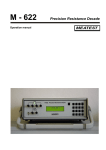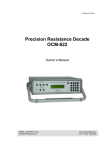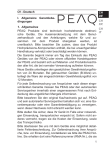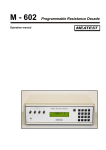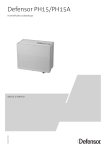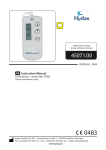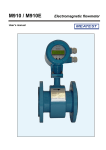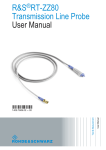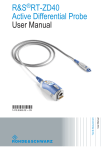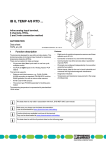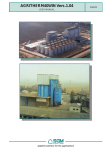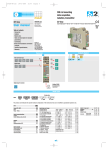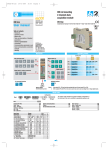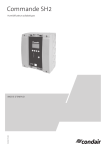Download Precision Decade model 1427 OPERATION MANUAL
Transcript
OPERATION MANUAL Precision Decade model 1427 ©2013 burster präzisionsmesstechnik gmbh & co kg All rights reserved Valid from: 29.10.2013 Manufacturer: burster praezisionsmesstechnik gmbh & co kg Talstrasse 1 – 5 P.O. Box 1432 76593 Gernsbach, 76587 Gernsbach, Germany Germany Tel.: Fax.: E-Mail: (+49) 07224 / 6450 (+49) 07224 / 64588 [email protected] www.burster.de 1392-BA1427EN-5170-101523 Precision Decade model 1427 Note: Exclusion of warranty liability for operating manuals All information in the present documentation was prepared and compiled with great care and reproduced subject to effective control measures. No warranty is provided for freedom from errors. We reserve the right to make technical changes. The present information as well as the corresponding technical data can change without notice. Reproduction of any part of this documentation or its processing or revision using electronic systems is prohibited without the manufacturer's prior written approval. Components, devices and measured value sensors made by burster praezisionsmesstechnik (hereinafter referred to as "product") are the results of targeted development and meticulous research. As of the date of delivery, burster provides a warranty for the proper condition and functioning of these products covering material and production defects for the period specified in the warranty document accompanying the product. However, burster excludes guarantee or warranty obligations as well as any liability beyond that for consequential damages caused by improper use of the product, in particular the implied warranty of success in the market as well as the suitability of the product for a particular purpose. Furthermore, burster assumes no liability for direct, indirect or incidental damages as well as consequential or other damages arising from the provision and use of the present documentation. Page 2 K o n f o r m i t ä t s e r k l ä r u n g (nach EN ISO/IEC 17050-1:2010) Declaration of conformity (in accordance with EN ISO/IEC 17050-1:2010) Name des Ausstellers: Issuer’s name: burster präzisionsmesstechnik gmbh & co kg Anschrift des Ausstellers: Issuer’s address: Talstr. 1-5 76593 Gernsbach, Germany Gegenstand der Erklärung: Object of the declaration: Rechnersteuerbare Hochpräzisions-Widerstands-Dekade Precision resistance decade Modellnummer(n) (Typ): Model number / type: 1427 Diese Erklärung beinhaltet obengenannte Produkte mit allen Optionen This declaration covers all options of the above product(s) Das oben beschriebene Produkt ist konform mit den Anforderungen der folgenden Dokumente: The object of the declaration described above is in conformity with the requirements of the following documents: Dokument-Nr Documents No. Titel Title Ausgabe/Ausgabedatum Edition/Date of issue 2006/95/EC Niederspannungsrichtlinie Low voltage directive 2006 2004/108/EC Elektromagnetische Verträglichkeit Electromagnetic Compatibility 2004 EN 61000-3-2 Elektromagnetische Verträglichkeit Grenzwerte für Oberschwingungsströme Electromagnetic Compatibility Limits for harmonic current emissions 2006 EN 61000-3-3 EN 61326-1 Gernsbach Ort / place Elektromagnetische Verträglichkeit Begrenzung von Spannungsänderungen, Spannungsschwankungen und Flicker in öffentlichen Niederspannungs-Versorgungsnetzen für Geräte mit einem Bemessungsstrom Electromagnetic Compatibility Limitation of voltage changes, voltage fluctuations and flicker in public low-voltage supply systems, for equipment with rated current Elektrische Mess-, Steuer-, Regel- und Laborgeräte EMV-Anforderungen - Teil 1: Allgemeine Anforderungen – industrielle Umgebung EMC Generic immunity 13.02.2013 Datum / date i.V. Christian Karius Quality Manager Dieses Dokument ist entsprechend EN ISO/IEC 17050-1:2010 Abs. 6.1g ohne Unterschrift gültig According EN ISO/IEC 17050 this document is valid without a signature. 2008 2006 Precision Decade Page 4 model 1427 model 1427 Precision Decade Table of Contents 1. 2. Introduction ........................................................................................................................ 7 1.1 Normal Use ............................................................................................................. 7 1.2 Customer Service ................................................................................................... 7 Description.......................................................................................................................... 8 2.1 3. 4. 5. Contents of delivery ................................................................................................ 8 2.1.1 RS232 version .......................................................................................... 8 2.1.2 IEEE488 version ....................................................................................... 8 2.2 Module 19” (extra ordered option) .......................................................................... 8 2.3 Construction ........................................................................................................... 9 2.3.1 Electric function......................................................................................... 9 2.3.2 Mechanical construction............................................................................ 9 Terminals and Controls ................................................................................................... 10 3.1 Terminals .............................................................................................................. 10 3.2 Keyboard .............................................................................................................. 11 3.3 Display .................................................................................................................. 12 Preparation for use .......................................................................................................... 13 4.1 Switching on ......................................................................................................... 13 4.2 Warm-up period .................................................................................................... 13 Operation .......................................................................................................................... 14 5.1 5.2 Standard mode ..................................................................................................... 14 5.1.1 Use of cursor keys .................................................................................. 14 5.1.2 Numerical keyboard ................................................................................ 15 Setup menu .......................................................................................................... 15 5.2.1 Function .................................................................................................. 16 5.2.2 R0, the resistance at 0 °C (Pt, Ni) ............................................................ 17 5.2.3 4W<2W (the highest resistance value on R4W terminals) ...................... 18 5.2.4 temperature unit (T. unit)......................................................................... 18 5.2.5 Click Volume (Volume)............................................................................ 19 5.2.6 Baud rate RS232 (optionally IEEE488 address) ..................................... 19 5.2.7 Lightning ................................................................................................. 20 5.2.8 Calibration mode password setting (Cal. code)....................................... 21 Page 5 Precision Decade 5.2.9 5.3 6. 7. 5.3.1 Recommended connection of standard ohm-meter ................................. 25 5.3.2 Calibrating................................................................................................ 26 Performance verification test ........................................................................................... 27 6.1 Required equippment ............................................................................................ 27 6.2 Decade setting ...................................................................................................... 27 6.3 Testprocedure ....................................................................................................... 27 6.4 Verifying parameters ............................................................................................. 27 Remote control .................................................................................................................. 30 7.1 Remote control RS232 .......................................................................................... 30 7.2 Remote control IEEE488 (optionally)..................................................................... 31 7.3 Commands ............................................................................................................ 32 7.4 9. Serial number (Serial n.) .......................................................................... 22 Calibration mode ................................................................................................... 23 7.3.1 8. model 1427 Syntax description ................................................................................... 32 Command list ........................................................................................................ 33 7.4.1 Value setting / reading ............................................................................. 33 7.4.2 Decade function setting ........................................................................... 34 7.4.3 I/D (device identification) ......................................................................... 34 7.4.4 R0 setting / reading .................................................................................. 35 7.4.5 Temperature unit setting (T.unit).............................................................. 35 7.4.6 Status reading.......................................................................................... 36 7.4.7 Value for switching over terminals 2W/4W (4W<2W) .............................. 36 Demo program................................................................................................................... 37 8.1 Installing the program ............................................................................................ 37 8.2 Program description .............................................................................................. 38 Specifications .................................................................................................................... 39 9.1 Page 6 Accuracy................................................................................................................ 41 model 1427 1. Introduction 1.1 Normal Use Precision Decade The resistance decade 1427 is a precise programmable resistance decade for a range from 1.000 00 Ω to 1 200 000 Ω. It is designed for checking parameters of resistance meters, regulators and process meters, which use external resistance sensors for the measurement of non-electric magnitudes. The preset resistance value is created by a appropriate combination of physical resistors. The Decade is equipped with a build-in function for the direct simulation of the most frequent temperature sensors, Pt and Ni. Relays with a low thermal voltage and stable foil resistors with low temperature coefficient are used as main parts of the decade. Set values are displayed on the front panel display. The 1427 is a sophisticated instrument with its own re-calibration procedure. This procedure allows the correction of any deviation in resistance without mechanical adjusting. The Instrument is especially designed for automatic testing procedures. A RS232 interface (optional IEEE488 bus) is used for linking the decade and a computer. 1.2 Customer Service burster praezisionsmesstechnik gmbh & co kg Talstraße 1 – 5 D-76593 Gernsbach Telefon: +49 – 7224 – 645 - 0 Fax: +49 – 7224 – 645 - 88 e-mail: [email protected] Page 7 Precision Decade 2. Description 2.1 Contents of delivery 2.1.1 RS232 version • Resistance decade 1427-V1xx • Power cord • Fuse 1.0 A T • RS232 Cable • Demo program • User’s manual • Test report 2.1.2 IEEE488 version • Resistance decade 1427-V2xx • Power cord • Fuse 1.0 A T • Demo program • User’s manual • Test report 2.2 model 1427 Module 19” (extra ordered option) The 1427 may be ordered as 19” module for an easy assembling into a 19” rack. Module height is 3HE. Order Code: 2316-Z001 Figure 1: Assembly frame for an easy assembly of 1427-Vxxx into a 19’’ rack. Page 8 model 1427 2.3 Construction 2.3.1 Electric function Precision Decade The resistance elements are switched to the output terminals with reed relays in a binary code system. The resistors are made of foil or metal with a low temperature coefficient. The relays used are types with a low thermoelectric voltage. The metal housing is connected to the ground terminal. Therefore the board with resistors and relays creates independent mechanical block. The CPU with a one-chip micro-controller generates all necessary internal control signals. Calibration data and set-up parameters are saved in a EEPROM memory. 2.3.2 Mechanical construction The decade housing is a standardized desktop housing made of aluminum. Keyboard and display are located at the front panel. The output terminals, the power cord socket with the fuse, the mains switch, the RS232 or the IEEE488 terminal and the ground terminal are located at the rear panel. Page 9 Precision Decade 3. Terminals and Controls 3.1 Terminals model 1427 Figure 2: Rear panel of 1427 Resistance output is available either on R4W or on R2W output terminals. 2 and 4 wire connection and, if the decade is used as Pt/Ni temperature sensor simulator, 2, 3 and 4 wire connection is available at the upper four Terminals, R4W. The resistance range of these Terminals lies between 1 Ω and a maximum R = 10 kΩ. The upper limit of “R” depends on the setting of the parameter 4W < 2W (refer to chapter 5.2.3). The lower line of terminals, with the label R2W, can only be used for 2 wire connection. The total resistance range at these terminals is from R = 1 Ω to 1.2 MΩ. The value of the lower limit R depends on the setting of the parameter 4W < 2W (refer to chapter 5.2.3). The decade switches automatically between R2W and R4W output terminals according to the resistance value. Low resistance values are always available at the R4W terminals. The over-switching value, from R4W to R2W terminals, is set at the SETUP menu (prameter 4 W < 2 W, refer to chapter 5.2.3). The range of this point setting covers values from 0 Ω to 10 kΩ. It may be set with a resolution of 1 Ω. The resistance of preset 4W < 2W value is still available on the R4W terminals. When 4W < 2W value is set to 0 Ω, the R2W terminals are used as output only. The recommended 4W < 2W value is 2000 Ω. Active terminals are indicated by a lighting LED at the rear panel. The left terminal with symbol “GROUND” is connected to the housing. Page 10 model 1427 3.2 Precision Decade Keyboard Figure 3: The Keyboard and the display are located at the front panel Numerical values may be entered from the numerical part of keyboard. The keys 2, 4, 6 and 8 also have a meaning as display cursor keys. The following keys are located at the keyboard, except from the numerical keys: Key Meaning MENU Enters the “SETUP/CALIBRATION” menus. BSP Deletes the last entered number. ESC Cancels last entered value or leaves the last set mode ENT Confirms set value or confirms the selected item in the MENU. It also switches between the numerical mode (black label) and display cursor mode of the keys 2, 4, 6 and 8. Switching over is indicated with the symbol “↑” in lower right corner of the display. Page 11 Precision Decade 3.3 model 1427 Display Figure 4: The two row display of 1427 The two-row alphanumerical display is located at the front panel of the decade. It is used to display all information. Main values, e.g. simulated temperatures or output resistances, are displayed in the upper row. Auxiliary information is displayed in the lower row. The following symbols may be displayed in lower right corner, depending on the status of the decade: keys 2, 4, 6 and 8 are switched to the cursor mode decade is in remote control via RS232 (IEEE488 optionally) Page 12 model 1427 4. Precision Decade Preparation for use The voltage supply has to be in the range from 100 V to 240 V, the frequency in range from 47 to 63 Hz. The 1427 decade is a laboratory device. Its accuracy is valid at a temperature of 23 °C ± 5 °C. The Instrument is aimed for the use in horizontal or slope position. The angle of slope is determined by its bottom foots. After unpacking put the instrument on a flat desk. If the instrument was stored out of range of reference temperatures: 4.1 Let it stabilize for at least one hour. Switching on Switch on the mains. The mains switch is located at the rear panel. After the switching on internal tests are performed for approx. 3 s. During this time the model name of the instrument and the manufacturers name are shown at the display. After finishing the tests, the setting of the decade operation is performed. Factory setting is the resistance mode, value 100 Ω ( 100 °F, 100 °C ). 4.2 Warm-up period After 10 min. warm-up period the decade meets its specified accuracy. The decade can operate immediately after the switching on. Note: Perform recalibration only if the warm-up period is finished. Page 13 Precision Decade 5. Operation 5.1 Standard mode model 1427 After switching on the decade operates in the standard mode. The following information is shown at the display: The upper row shows the simulated temperature in “°C” or the generated resistance in “Ω”. The lower row shows the type of the simulated temperature sensor (Pt100) and the setup temperature scale IPTS68 or ITS90 according to the IEC751 standard or US according to the US/JIS standard. The arrow symbol in the right corner informs that the cursor mode of the keys 2, 4, 6 and 8 is initialized. The buttons ▲ and ▼ enable to step up or down the number on the active position. The buttons ◄ and ► move the active position of the cursor to left or right. Switching between cursor and numerical mode: Push the ENT key. Activating the SETUP mode: 5.1.1 Push the MENU key. Use of cursor keys The Cursor keys ▲ and ▼ enables to increase or decrease the number on the active position. The active position is signed by the symbol “_” at the desired number. With cursor keys ◄ and ► you’ll change the active position of the cursor. Push the ENT key to switch the keys 2, 4, 6 and 8 between cursor and numerical mode. The arrow in the lower right corner shows that the keys are in cursor mode. Page 14 model 1427 5.1.2 Precision Decade Numerical keyboard With the numerical keys temperature or resistance values may be entered directly. A recently entered value is displayed in brackets under the active value. To confirm the new value: Push the ENT key. Pushing the ENT key switches the keys 2, 4, 6 and 8 to cursor mode. To delete the last entered number: Push the BSP key. To exit setting mode: 5.2 Press the ESC key. Setup menu This mode enables to set or display some auxiliary parameters. To enter the setup mode: Push the MENU key at standard mode. To call up parameters: Call up the desired parameter with cursor key ▲ or ▼. You’ll find a description of the Parameters an their settings at chapter 5.2.1 to 5.2.9 To leave the setup mode: Push the ESC key. Page 15 Precision Decade 5.2.1 model 1427 Function Push the MENU key at standard mode. Call up the “Function” parameter with cursor key ▲ or ▼. Set the decade to the desired mode. To do this, use the cursor keys ◄ and ►. The available modes are shown at the following. The Menu Items are displayed at the lower row. After selecting an item and pressing the button ENT, the identifier of the new selected temperature/resistance function is shown at the upper row. The selected function is valid even if the instrument is switched off and on again (except of Short and Open functions). R Resistance mode. The total range of resistance is 1.00 000 Ω to 1 200 000 Ω. Pt(68) Simulation of Pt temperature sensors according to standard IEC751 (temperature scale IPTS68, coefficient 1.3850). The range of setting is –200 °C to 850 °C (-328 °F to 1562 °F). The parameter R0 (resistance at 0 °C) is variable in the range 10 Ω to 20 000 Ω. Pt(90) Simulation of Pt temperature sensors according to standard DIN EN 60751 (temperature scale ITS90, coefficient 1.3851). The range of setting is –200 °C to 850 °C (-328 °F to 1562 °F). The parameter R0 (resistance at 0 °C) is variable in the range 10 Ω to 20 000 Ω. Pt(US) Simulation of Pt temperature sensors according to standard US/JIS (temperature scale ITS90, coefficient 1.3916). The range of setting is –200 °C to 850 °C (-328 °F to 1562 °F). The parameter R0 (resistance at 0 °C) is variable in the range 10 Ω to 20 000 Ω. Ni Simulation of Ni temperature sensors according to standard DIN43760 (coefficient 6180). The Range of setting is –60 °C to 300 °C (-76 °F to 572 °F). The parameter R0 (resistance at 0 °C) is variable in the range 10 Ω to 20 000 Ω. Page 16 model 1427 Precision Decade User By user defined temperature function. As default, a NTC thermistor sensor R(T) = 330*exp (-4050*((1/298.15)-(1/(T+273.15)))) is preset. with the temperature function The range of simulation is –30 °C to 110 °C. Short (Version 1427-Vx1x) Simulates “Short” at the output terminals. The function “Short” is an extra ordered option. Open (Version 1427-Vx1x) Simulates “Open” on the output terminals. The function “Open” is an extra ordered option. 5.2.2 R0, the resistance at 0 °C (Pt, Ni) This function allows the setup of the parameter R0 for temperature sensors. The seting is valid for both Pt and Ni sensors. To set a R0 value: Press the “MENU” key at standard mode. Select the Parameter “R0” with the cursor keys ▲ and ▼. Switch the keypad to numerical mode. To do this, press the “ENT” button. Insert the new value of R0. The range between 10 Ω and 20 000 Ω is allowed. Confirm new value. To do this, press the “ENT” button. At this moment the setup of the new value is finished. Note: The new value is valid even if the instrument is switched off and on again. Page 17 Precision Decade 5.2.3 model 1427 4W<2W (the highest resistance value on R4W terminals) Use this function to define the resistance value, for the switch over of the active output terminals from R4W to R2W and back automatically. Resistance values higher than 10 000 Ω are only available on terminals R2W. Lower values than 10 000 Ω are available either on R2W terminals or on R4W terminals. But the R4W terminals are more accurate. The allowed range of R4W lies between 1 Ω and 10 000 Ω. To set a value: Press the “MENU” key at standard mode. Select the Parameter “4W<2W” with the cursor keys ▲ and ▼. Switch the keypad to numerical mode. To do this, press the “ENT” key. Use the numerical keys to insert the new value. Confirm the new value. To do that press the “ENT” key. At this moment the setup of the new switch over point value is finished. Note: The new value is valid even if the instrument is switched off and on again. 5.2.4 temperature unit (T. unit) Press the “MENU” key at standard mode. Select the Parameter “T. unit” with the cursor keys ▲ and ▼. Select the desired unit with the keys ◄ and ►. Available are the units “Celsius” (°C) and “Fahrenheit” (°F). Both units are shown at the lower row. Confirm new value. To do that press the “ENT” key. At this moment the setup of the temperature unit is finished. Note: The new unit is valid even if the instrument is switched off and on again. Page 18 model 1427 5.2.5 Precision Decade Click Volume (Volume) Press the “MENU” key at standard mode. Select the Parameter “Volume” with the cursor keys ▲ and ▼. Select the desired volume with the keys ◄ and ►. You may set the volume incremental. There are 15 increments of volume. “00” means no click when a key is pressed and “15” means a loud click. The new set volume is valid at the parameter “Volume”. It is not valid outside of this parameter until the volume is confirmed. Confirm new value. To do that press the “ENT” key. At this moment the setup of the click volume is finished. Note: The new volume is valid even if the instrument is switched off and on again. 5.2.6 Baud rate RS232 (optionally IEEE488 address) This parameter allows the setup of the RS232 interface’s baud (Bd) transfer rate. To set the transfer rate of a RS232 decade: Press the “MENU” key at standard mode. Select the Parameter “Baud rate RS-232” with the cursor keys ▲ and ▼. Select the desired transfer rate with the keys ◄ and ►. These baud rates are available: o 300 Bd o 600 Bd o 2 400 Bd o 9 600 Bd o 1 200 Bd o 4 800 Bd o 19 200 Bd The baud rates are displayed at the lower row. Confirm new value. To do this, press the “ENT” key. After pressing the “ENT” key the new baud rate is written to the upper row. At this moment the setup of the new transfer rate is finished. Note: The last set baud rate is valid even if the instrument is switched off and on again. Page 19 Precision Decade model 1427 To set the address off an IEEE488 decade (IEC addr): If the decade is equipped with an optional IEEE488 Interface, you may set the IEEE488 address of instruments instead of the “Baud rate”. The address range is “0” to “30”. 5.2.7 Lightning Using this parameter you may enable or disable the display lightning. The decade disables the display lightning after a set time, if no key is pressed. To set a time: Press the “MENU” key at standard mode. Select the parameter “Lightning” with the cursor keys ▲ and ▼. Use the keys ◄ and ►to select the time to disable the display lightning. These settings are available: o “OFF” (The lightning is disabled) o “5 m” (The lightning is disabled 5 minutes after the last hit of a key.) o “30 s” (The lightning is disabled 30 seconds after the last hit of a key.) o “ON” (The lightning is enabled at all time) The setting is displayed at the lower row. Confirm new setting. To do that, press the “ENT” key. After pressing the “ENT” key the new setting is written to the upper row. At this moment the setup of the display lightning is finished. Page 20 model 1427 5.2.8 Precision Decade Calibration mode password setting (Cal. code) To access the calibration mode you have to enter a five digit password. If the password is set to “00000”, this information is displayed in the setup menu. Otherwise the decade displays “*****”. Note: Write down the active password. If you forget the calibration code, you have to send the decade to buster. To change the password: Press the “MENU” key at standard mode. Select the Parameter “Cal.code” with the cursor keys ▲ and ▼. Switch the keypad to numerical mode. To do this, press the “ENT” key. If the old password is “00000”: Use the numerical keys to insert the new password. Confirm the new password with the “ENT” key. The new password is not shown at the menu. If another password is set: Insert the old password. Confirm the old password with the “ENT” key. After the old password is entered correct the decade displays “00000”. Use the numerical keys to insert the new password. Confirm the new password with the “ENT” key. The new password is not shown at the menu. Note: The new password is valid even if the instrument is switched off and on again. Page 21 Precision Decade 5.2.9 Serial number (Serial n.) Displays the serial number of the decade. To display the serial number: Press the “MENU” key at standard mode. Select the Parameter “Serial n.” with the cursor keys ▲ and ▼. The display now shows the serial number. Note: This parameter cannot be changed. Page 22 model 1427 model 1427 5.3 Precision Decade Calibration mode In this mode you may recalibrate the resistance elements of the decade. To get access to the calibration mode: Press twice the “MENU” key at standard mode. At SETUP mode you have to press this key only at one time. Before calibration you have to enter the correct password. Without a correct password the access to the calibration mode is refused. The default calibration code is “00000”. To return to standard mode: Press the “ESC” key. The recalibration procedure consists of the measuring of 36 basic resistance values and of entering their current measured data. During calibration you are able to adjust the values with the ▲ and ▼ keys. Note: The nominal values can vary but there is no influence to the accuracy. The nominal values of the calibration points and the requested recalibration accuracy are described in the table following: Table 1: Calibration points and requested accuracy Standard (terminals) Nominal value Requested Accuracy R00 (R4W) 2.0 Ω 1 mΩ R01 (R4W) 3.9 Ω 1 mΩ R02 (R4W) 7.8 Ω 1 mΩ R03 (R4W) 15.4 Ω 1 mΩ R04 (R4W) 30.5 Ω 1 mΩ R05 (R4W) 60.5 Ω 1 mΩ R06 (R4W) 120 Ω 2 mΩ R07 (R4W) 237 Ω 3 mΩ R08 (R4W) 464 Ω 6 mΩ R09 (R4W) 909 Ω 15 mΩ R10 (R4W) 1780 Ω 30 mΩ Page 23 Precision Decade model 1427 Standard (terminals) Nominal value Requested Accuracy R11 (R4W) 3480 Ω 100 mΩ R12 (R4W) 6870 Ω 250 mΩ R13 (R4W) 13.5 kΩ 500 mΩ R14 (R4W) 26.6 kΩ 1Ω R15 (R4W) 52.2 kΩ 5Ω R16 (R4W) 103 kΩ 10 Ω R17 (R4W) 202 kΩ 20 Ω R18 (R4W) 398 kΩ 40 Ω R19 (R4W) 780 kΩ 80 Ω R20 (R4W) 1540 kΩ 200 Ω R21 (R4W) 3020 kΩ 400 Ω R22 (R4W) 5920 kΩ 1 kΩ R23 (R4W) 12 MΩ 5 kΩ R24 (R4W) 23 MΩ 50 kΩ R25 (R4W) 48 MΩ 200 kΩ R26 (R4W) 100 MΩ 500 kΩ R27 (R2W4W) 1780 Ω 40 mΩ R28 (R2W4W) 3830 Ω 80 mΩ R29 (R2W4W) 7870 Ω 100 mΩ R30 (R2W4W) 15,8 kΩ 200 mΩ R31 (R2W4W) 34 kΩ 500 mΩ R32 (R2W4W) 75 kΩ 1Ω R33 (R2W4W) 150 kΩ 4Ω R34 (R2W4W) 301 kΩ 10 Ω R35 (R2W4W) 602 kΩ 20 Ω Page 24 model 1427 5.3.1 Precision Decade Recommended connection of standard ohm-meter Terminals R4W for calibration points R00 to R26: Terminals R2W for calibration points R27 to R35: Page 25 Precision Decade 5.3.2 model 1427 Calibrating Set the first calibration point (resistance element). Use the keys ▲ and ▼ to set the element. Measure the resistance of the selected element. Use a ohm-meter with appropriate accuracy in 4 and 2-wire wire connection. Switch the keypad to numerical mode. To do this, press the “ENT” key. Insert the measured resistance value in Ohms (Ω). You’ll find the original value in the upper row and the new value in the lower row. Confirm the new calibration data by pressing the “ENT” key. Repeat the procedure described above for all resistance elements. Page 26 model 1427 6. Precision Decade Performance verification test The verification procedure is based on the measuring of the resistance at the decade output terminals with a standard multimeter in recommended points. 6.1 Required equippment You need an ohmmeter with a nominal accuracy of 0.001 % in range 1 Ω to 1.2 MΩ (e.g. Wavetek 1281, FLUKE 8508 or similar). 6.2 Decade setting Switch the decade to resistance mode. Connect the standard multimeter to the output terminals of the decade. Use four-wire connection. 6.3 Testprocedure • Checking output resistance on terminals R4W. • Checking output resistance on terminals R2W. 6.4 Verifying parameters To perform a parameter verification test: Switch on both instruments. Wait at least for one hour During this time both instruments have to stabilize at a laboratory ambient with a temperature of 23±2 °C. After the waiting period: Connect the resistance decade terminals R4W to the standard ohm-meter (multimeter). Set 4W<2W value to 10 kΩ. This value is set at the “SETUP” menu. Check the resistance value at the checkpoints according to table: “Maximum deviations (R4W)”. Page 27 Precision Decade Table 2: Maximum deviations (R4W) Nominal value [Ω] Max. deviation [mΩ] 1.00000 3.03 2.00000 3.06 5.00000 3.15 10.00000 3.3 20.0000 3.6 50.000 4.5 100.000 6.0 200.00 9.0 500.00 model 1427 25 1000.0 50 2000.0 100 5000.0 750 10000.0 1500 Connect the standard ohm-meter to the R2W terminals of the resistance decade. Use four-wire connection for a range up to 10 kΩ. Above this point you can use both two-wire and four-wire connection. At “SETUP” menu set the parameter “4W<2W” to 0 Ω. Check resistance value at checkpoints according to table: “Maximum deviations (R2W)”. Page 28 model 1427 Table 3: Precision Decade Maximum deviations (R2W) Nominal value [Ω] Max. deviation [Ω] 1.00000 0.01 10.00000 0.011 100.000 0.015 1000.0 0.060 2000.0 0.1 5000.0 0.25 10000.0 0.5 20000.0 1.0 50000 2.5 100000 5.0 200000 20 500000 50 1000000 100 1200000 120 Page 29 Precision Decade 7. model 1427 Remote control The standard version of the 1427 is equipped with a RS232 interface. The IEEE488 version is described in chapter 7.2: “Remote control IEEE488 (optionally)”. A large part of the commands are the same for both versions. 7.1 Remote control RS232 • Transmission baud rate may be selected from 300 to 19200 Bd. • Number of data bits is 8. • Number of stop bits is 1. • No parity. You’ll find further information about the transmission rate at chapter 5.2.6. For data flow control neither hardware handshake (RTS/CTS) nor program handshake (XON/XOFF) is used. The RS232 line is metallically separated to other electronic circuits. RS232 connection 4 5 9 2 3 8 7 1 6 Figure 5: 9 pin connector D-SUB FEMALE (view to the 1427’s rear panel) Pin Label I/O Description 2 TXD output Transmitter 3 RXD input Receiver 5 GND - Ground Cable between decade and computer (configuration 1:1) Page 30 Computer D-Sub 1 D-Sub 2 1427 Receiver 2 2 Transmitter Transmitter 3 3 Receiver Ground 5 5 Ground model 1427 7.2 Precision Decade Remote control IEEE488 (optionally) The following list of commands is valid for decades with IEEE488 interface. The decade performs the following functions based on IEEE488 bus commands. SH1, AH1, T5, L3, RL1, DC1 The 1427 also recognizes the following general commands: “DCL” Device Clear - resets the 1427 to its delivery status “SDC” Selected Device Clear - resets the 1427 to its delivery status “GTL” Go To Local - disables the remote control “LLO” Local Lock Out - disables the local control, the 1427 can only be controlled by remote control. Other commands are identical to the RS232 interface commands. You’ll find a detailed description at chapter 7.3 “Commands” and at chapter 7.4 “Command list”. Figure 6: Plug arrangement IEEE488 Interface Page 31 Precision Decade 7.3 model 1427 Commands The communication between decade and computer consists of a flow of the two command types command-response and query-response. A command is always a letter followed by a parameter and ended by control sign <cr> or <lf>. The response is always ended with the control signs “<cr><lf>”. If an unknown command is received the 1427 returns the string "? <cr><lf>“. A correct executed command is confirmed by the string "Ok <cr><lf>. If a correct query is received the 1427 returns the response in the format described above. All commands have to contain the sign <cr> or <lf> at the end. Both small and large letters can be used. 7.3.1 Syntax description <DNPD> Decimal Numeric Program Data, this format is used to express decimal number with or without exponent. <CPD> Character Program Data. Usually this format represents a group of alternative character parameters e.g. {0 | 1 | 2 | 3}. ? A flag indicating a request for the value of the parameter specified by the command. No other parameter than the question mark can be used. (?) A flag indicating a request for the parameter specified by the command. This command permits a value to be set as well as requested. <cr> „carriage return“. ASCII code 13. This code executes the program “line”. <lf> „line feed“. ASCII code 10. This code executes the program “line”. Page 32 model 1427 7.4 Command list 7.4.1 Value setting / reading Precision Decade A (?) <DNPD> This command sets a resistance (resistance function) or temperature value (temperature sensor simulating mode). <DNPD> Represents a resistance value in Ohm or a simulated temperature in °C. If the temperature mode is activated, both negative and positive values are acceptable. At resistance mode only positive values are acceptable. The limit values are shown in chapter 9: “Specifications”. In case of a command, the decade confirms the correct setting with the string „Ok <cr><lf>”. In case of a query, the 1427 returns the set resistance/temperature value in the same format as it is set for the display (number of decimal places). For example the value -120 °C is returned as -120.000<cr><lf>. Positive numbers are sent without polarity sign. Example: The command “A123.564 <cr>” sets the temperature 123.564 °C, if the decade is in temperature simulation mode. If the decade is in resistance mode, 123.564 Ω will be set. If only the query „A?<cr>” is sent, the decade returns the response in the format „123.564<cr><lf>”. Page 33 Precision Decade 7.4.2 model 1427 Decade function setting F <CPD> { 0 | 1 | 2 | 3 | 4 | 5 | S | O } The following functions are available: Code Function 0 resistance mode 1 Pt(68) temperature sensor simulation 2 Pt(90) temperature sensor simulation 3 Pt(US) temperature sensor simulation 4 Ni temperature sensor simulation 5 Custom temperature sensor simulation S Short simulation (extra ordered option) O Open simulation (extra ordered option) The 1427 confirms the execution with the string „Ok <cr><lf>”. Example: „F1<cr>” sets the simulation of a Pt100 sensor (temperature scale IPTS68). 7.4.3 I/D (device identification) *IDN? The response contains the name of the manufacturer, the model type number, the serial number and the firmware version. Example: If query “*IDN?<cr>” is sent, the decade returns the response: „BURSTER,1427,462351,2.4 <cr><lf>“. Page 34 model 1427 7.4.4 Precision Decade R0 setting / reading R (?) <DNPD> This Command sets the resistance value to 0 °C. The setting of R0 is valid for all types of simulated temperature sensors. <DNPD> Represents the resistance value R0 in Ω. The limits are shown in chapter 9 “Specifications”. The 1427 confirms the execution with the string „Ok <cr><lf>”. In case of a query the 1427 returns the set value in Ω. Example: „R100 <cr>” sets the value R0 to 100 Ω (Pt100, Ni100). After the query „R?<cr>” the decade returns the string „100<cr><lf>”. 7.4.5 Temperature unit setting (T.unit) U <CPD> { 0 | 1 } This Command sets the used temperature unit. Code Function 0 sets degrees of Celsius (°C) 1 sets degrees of Fahrenheit (°F) The 1427 confirms execution with the string „Ok <cr><lf>”. Example: „U0<cr>” sets °C as temperature unit. Page 35 Precision Decade 7.4.6 model 1427 Status reading V? 1427 returns the device status in the form „FxUx <cr><lf>“. The values corresponding to the actual status of decade are located at the positions of the „x“ signs (refer to chapter 7.4.2: “Decade function setting” and chapter 7.4.5: “Temperature unit setting (T.unit)”. Example: After the query „V?<cr>” the decade returns the string „F2U0<cr><lf>”, which means the actual setting is Pt (90) and “°C”. 7.4.7 Value for switching over terminals 2W/4W (4W<2W) W (?) <DNPD> This command sets the value, where the resistance output is switched from R4W to R2W and back. <DNPD> Represents the resistance value in Ω. The limits are shown in chapter 9: “Specifications”. The 1427 confirms the execution with the string „Ok <cr><lf>”. In case of a query the 1427 returns the set value in Ω. Example: „W2000 <cr>” sets the value to 2000 Ω. After the query „W?<cr>” the decade returns the string „2000<cr><lf>”. Page 36 model 1427 8. Precision Decade Demo program To provide an easy operation of the instrument from the computer, and to check the RS232 line (IEEE488 bus) of the instrument, a simple operating program is delivered with the decade. The installation disk contains a program (for WIN95/98/ME/NT/2000/XP/WIN7/WIN8 only), that allows your computer to communicate with the instrument through a standard serial line (IEEE488). For example, you may set a value or function on the decade. For a IEEE488 connection, this Demo program requires a properly configured National Instruments IEEE488 card. 8.1 Installing the program Launch “SETUP.EXE”. The installation program asks for the destination directory (pre-defined is “R Decade”). Insert another directory or confirm “R Decade”. The installation program executes the installation. The file “UNINST.EXE” is also copied into the selected directory, for an alternative delete of the directory from the system. Page 37 Precision Decade 8.2 model 1427 Program description When launching the program “R decade”, the following control panel is displayed on your screen. Figure 7: R Decade First select the appropriate interface (RS232 or IEEE488). To select the interface use the operating element „Communication“. Standard is RS232. To control the decade with the RS232 Interface. Set the serial port number to which the instrument is connected and the baud rate. Click the “Open” button. After pushing the “Open” button the program checks the connection to the instrument. If an instrument is found, you can control it. To control the decade with the IEEE488 interface. Set the IEEE488 address. Click the “Open” button. After pushing the “Open” button the program checks the connection to the instrument. If an instrument is found, you can control it. Set an output value: Insert the desired value at the window “Output” or use the ▲ and ▼ keys. To exit the program: Page 38 Click the “Exit” button. model 1427 9. Precision Decade Specifications Only values, functions, ranges with signed accuracy in relative or absolute expression or where limits are specified, are guaranteed. Resistance range 1.000 00 Ω - 1 200 000 Ω SHORT, OPEN terminals (version 1427-Vx1xx only) Pt sensor temperature simulation -200.000 °C to 850.000 °C (-328 °F to 1562 °F) Ni sensor temperature simulation -60.000 °C to 300.000 °C (-76 °F to 572 °F) Type of temperature sensors Pt10 to Pt20000, Ni10 to Ni20000 Resolution 0.000 01 Ω for Pt temperature standards 1.000 00 Ω 10.0001 to 10.000 00 Ω Ω to 100.000 0 Ω 0.000 1 Ω for 0.001 Ω for 100.001 Ω to 400.000 Ω 0.01 Ω for 400.01 Ω to 1 200.00 Ω 0.1 Ω for Ω to 30 000.0 Ω 1Ω for Ω to 1 200 000 Ω 0.001 °C for Pt10 toPt300 and Ni10 to Ni300 0.01 °C, for Pt301 to Pt10000 and Ni301 to Ni10000 1200.1 30000 IEC 751 (1,3850 for IPTS68) DIN EN 60751 (1,3851 for ITS90) US (US/JIS) (1,3916) Ni temperature standards DIN 43760 (6180) Temperature coefficient < 1 ppm/ °C (1 Ω - 2000 Ω) on terminals R4W < 1 ppm/ °C (100 Ω - 1200 kΩ) on terminals R2W < 5 ppm/ °C (2 kΩ - 10 kΩ) on terminals R4W Maximal dissipation power 0,3 W Maximal voltage 50 V DC, 50 Vef AC on terminals R4W 50 V DC, 50 Vef AC on terminals R2W Connection of output terminals 2, 4 wire Connection of temperature sensors 2, 3 or 4 wire Reaction time * 6 ms Terminals (output) instrument terminals diameter 4 mm, gold plated Interface RS232 as standard (optionally IEEE488) Power line 100-240 V AC, 47 – 63 Hz Power consumption 10 VA max Page 39 Precision Decade Safety class I according EN61010 Uses external fuses T 1.0 A Uses internal fuses T 2.0 AH Reference temperature +18 °C … +28 °C Working temperature +5 °C … +40 °C Storing temperature -10 °C … +50 °C Housing ALU (aluminium) Dimensions (table version) Width: 250 mm Height: 100 mm model 1427 Depth: 390 mm Dimensions (19” module) Width: 483 mm Height: 133 mm Depth: 390 mm Weight 4.5 kg Isolation resistance between output terminals and housing > 2 GΩ (at 500 V DC) *Reaction time means time interval between setting up value from front panel or receiving command from remote control bus and settling set-up value on output terminals. Note: Only data shown with tolerance or with band of limits are tested. All other values only have informative character. Note: During over-switching, resistance circuit may be opened for a period of about 1 ms. Page 40 model 1427 9.1 Precision Decade Accuracy Specified accuracy is valid after a 10 minute warm up period in temperature of 23 ± 5 °C. Uncertainties include long-term stability, temperature coefficient, linearity, load and line regulation and traceability of factory to national calibration standards. Accuracies are assigned in % of the set value. The Specified accuracy is valid for one-year. Table 4: Resistance accuracy (terminals R4W) Range Accuracy 1 Ω - 400 Ω 0.003 % + 3 mΩ 400 Ω - 2000 Ω 0.005 % 2000 Ω - 10000 Ω 0.015 % Maximal thermoelectric voltage on terminals R4W in resistance range 1 Ω to 2 kΩ is 1 µV and in range 2 kΩ to 10 kΩ is 5 µV. Table 5: Resistance accuracy (terminals R2W) Range Accuracy 1 Ω - 2000 Ω 0.005 % + 10 mΩ 2 kΩ - 200 kΩ 0.005 % 200 kΩ - 1200 kΩ 0.01 % The maximum thermoelectric voltage on terminals R2W in resistance range 1 Ω to 2 kΩ is 5 µV and in range 2 kΩ to 1.2 MΩ is 15 µV. Table 6: Pt temperature sensor simulation accuracy Range Pt100 (R4W) Pt200 (R4W) Pt500 (R4W) Pt1000 (R4W) Pt10000 (R2W) -200 to 200 °C 0.02 °C 0.02 °C 0.02 °C 0.04 °C 0.04 °C 200 to 500 °C 0.03 °C 0.04 °C 0.06 °C 0.1 °C 0.06 °C 500 to 850 °C 0.04 °C 0.06 °C 0.15 °C 0.2 °C 0.1 °C Table 7: Ni temperature sensor simulation accuracy Temperature range Ni100 (R4W) Ni1000 (R4W) Ni10000 (R2W) -60 to 300 °C 0.02 °C 0.04 °C 0.04 °C Page 41 Precision Decade model 1427 Short and Open simulation (version 1427-VX1X only) When the SHORT function is selected, the output resistance is lower than 100 mΩ (typically 50 mΩ). The maximum allowed current is 500 mA. When OPEN function is selected, the output resistance is higher than 1 GΩ. The maximum allowed voltage is 50 V eff. on terminals R4W and 50V DC, 50 V eff. AC on terminals R2W. Note: Resistance values in range 1 Ω to 1.2 MΩ are absolutely calibrated. The resistance value is not defined against SHORT position. The functions SHORT and OPEN (positions) are intended only for a functional checking of tested instrument. Page 42










































